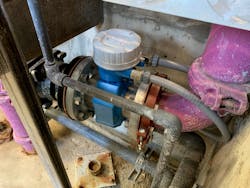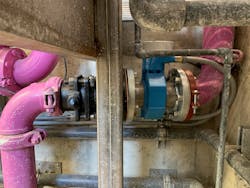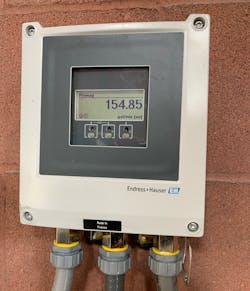Flowmeter Improves Measurement Accuracy for Oregon Wastewater Facility
Set along the foothills of Oregon’s Blue Mountains, on either side of the Umatilla River is the “True West” city of Pendleton. Known for its rich western heritage, legendary rodeo, woolen mills and underground tunnels, the town is steeped in tradition. Just along the Umatilla riverbed is the city of Pendleton’s Wastewater Treatment Resource Recovery Facility (WWTRRF) which plays a vital role in the safety and supply of one of the town’s most valuable resources: water. The facility serves a population of 17,000 people and treats roughly 2.5 million gallons of water per day (GPD).
Like all wastewater treatment facilities, the City of Pendleton WWTRRF faces the daily challenge of maintaining water safety and quality for the city while improving energy consumption and meeting city, state and national regulations. This makes consistent and reliable measurement essential to the entire process. With reliable measurement, technicians can better control the process, make better decisions, implement predictive maintenance, and save both money and energy.
However, in the tight and restrictive spaces in water treatment facilities, it can be difficult to install the necessary instrumentation. Between short pipe runs, sharp bends and other challenging applications, it can be costly and time consuming to fit devices in the places they’re most useful and necessary. The City of Pendleton faced this challenge at the WWTRRF until they installed Endress+Hauser’s Promag W unrestricted mounting 0xDN electromagnetic flowmeter, which provides stable measurement regardless of mounting location.
Before implementing the Promag W 0xDN, the City of Pendleton wastewater treatment facility was unable to obtain flow measurements for process water used within the facility. Employees were estimating the flow rate and amount of water coming through but were not able to get exact numbers. This was a difficult spot for a flowmeter because there was not a sufficient straight run — instead, the flow runs vertical through a 90-degree elbow and then connects to a full port valve.
Before the Promag W, their options were limited and costly as typical electromagnetic flowmeters require straight pipe run of 3-5 pipe diameters upstream of the meter and 1-2 diameters downstream of the meter. In some situations, facilities could modify the piping to increase the length of the pipe run to comply with recommended inlet and outlet runs, but, because of the limited space, this wasn’t a viable option. The other possibility would be to install an electromagnetic reduced bore flowmeter; however, these meters create a pressure drop resulting in higher energy costs and lower plant efficiency.
Endress+Hauser’s Proline Promag W 400 for water and wastewater applications was chosen because it offers unrestricted mounting. The first of its kind, the magmeter is particularly designed to measure flow independently of flow profile and mounting location without sacrificing pressure or efficiency.
Kyle Willman, the WWTRRF lead technician attended an Endress+Hauser online seminar where the subject matter experts discussed the new technology. Willman reached out to Cameron Bachman with Field Instruments and Controls, the local Endress+Hauser sales and service representative, to learn more about the electromagnetic flowmeter capabilities.
Willman saw how the new technology would fit the goals of the treatment facility and made the decision to purchase the device. The electronic flowmeter was easily installed without having to rip up sections of piping to extend the lay length, saving the city any additional installation costs. With the ability to retrieve accurate data regardless of flow profile and flow rate, the City of Pendleton WWTRRF can operate at a higher efficiency and lower cost.
“This wasn’t an ideal placement for a flowmeter before, so they were having to estimate the flow rate,” said Bachman. “But having a steady flow helps technicians make better decisions. Better flow, better decisions.”
The City of Pendleton WWTRRF has been able to gain accurate and repeatable flow and total readings since the installation of the Promag W 400 0xDN. With the addition of the Promag, they can collect live data and totalize the flow over a 24-hour period. This helps identify problems like leaks or open valves much quicker, which reduces water waste. Before the Promag, it was hard to catch a leak until thousands of gallons of water had already been lost. It would take longer to notice the problem and longer to identify the solution.
Not only does accurate data allow for quicker response times, but, by trending the data, it also enables technicians to run predictive modeling to prevent problems before they occur. This further minimizes energy and water loss, and allows the plant to operate at a higher level of safety, efficiency and overall plant performance. WW
About the Author: Adam Booth is the flow product marketing manager for Endress+Hauser. He graduated from Purdue University in 2016 with a degree in mechanical engineering technology. After graduation, he joined Endress+Hauser’s Rotational Engineering Development Program in 2016. Prior to his current role, Booth was a technical support engineer for Endress+Hauser. While in those roles, he developed expertise with Endress+Hauser’s flow portfolio and gained hands-on experience in the field.
About the Author
Adam Booth
Adam Booth is the Flow Product Marketing Manager for Endress+Hauser. He graduated from Purdue University in 2016 with a degree in Mechanical Engineering Technology. After graduation he joined Endress+Hauser’s Rotational Engineering Development Program in 2016. Prior to his current role, Booth was a Technical Support Engineer for Endress+Hauser. While in those roles, he developed expertise with Endress+Hauser’s Flow portfolio and gained hands-on experience in the field.



